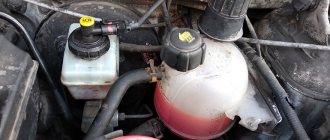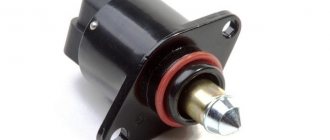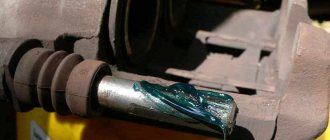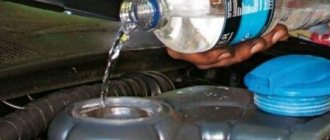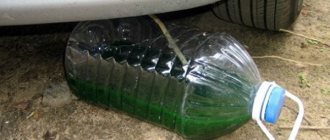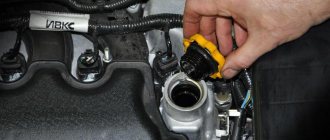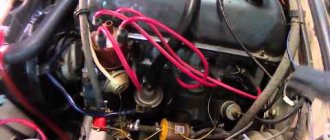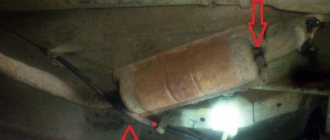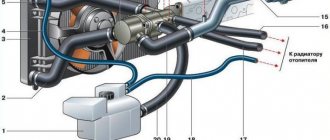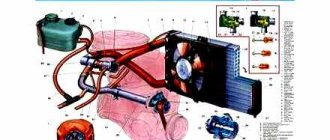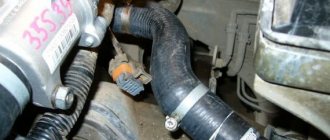Technology for pumping the brake system with ABS for Lada Kalina
Bleeding brakes with ABS, taking into account the characteristics of the system ↑
Bleeding the brake system with ABS will require you to have certain technical skills. In addition, it will not be superfluous to first study the manual on the design and maintenance of the brake system of your car.
Features of bleeding brakes with ABS:
in cars that have a hydraulic valve block, a hydraulic accumulator and a pump in one unit, replacing the brake fluid and bleeding the brake system with ABS is carried out in the same way as bleeding the brakes on a car without ABS (you need to turn off the system by removing (disabling) the fuse). Bleeding of the circuits is carried out with the brake pedal pressed, the RTC bleeder fitting must be unscrewed. The ignition is turned on and the pump expels air from the circuit. The bleeder screw is tightened and the brake pedal is released. An extinguished ABS fault light is evidence that your actions were correct. Bleeding the brake system with ABS, in which the hydraulic module with valves and the hydraulic accumulator are separated into separate units, is carried out using a diagnostic scanner to retrieve information from the ABS ECU. It's unlikely you have one. Therefore, bleeding of brakes with ABS of this type should most likely be done by you at a service station. Bleeding the brake system with ABS and electronic activation systems (ESP or SBC) is carried out only under service conditions. How to bleed ABS brakes? ↑
It is important! It should be remembered that the pressure in the brake system reaches 180 atm. Therefore, in order to prevent the release of brake fluid, before disconnecting the brake lines on any system with ABS, it is necessary to discharge the pressure accumulator. To do this, with the ignition off, press the brake pedal 20 times.
Technology for bleeding the brake system with ABS
Bleeding brakes with ABS, like bleeding a conventional brake system, is done with an assistant. Turn off the ignition (position “0”). Disconnect the connectors on the brake fluid reservoir.
Front wheel brakes:
put the hose on the bleeder fitting; open the fitting back; the brake pedal is pressed all the way and held in the depressed position; we observe the release of an “aired” mixture; tighten the fitting and release the pedal. Rear right wheel brake:
put the hose on the bleeder fitting, unscrew it one turn; press the brake pedal all the way, turn the ignition key to position “2”. In this case, the brake pedal is held in the pressed position; a running pump will expel air from the system. That is, as soon as the brake fluid begins to come out without air bubbles, close the fitting and release the brake. Rear left wheel brake
The hose is put on the fitting and unscrewed 1 turn; DO NOT press the brake pedal; a working pump pushes out the “aired” mixture; press the brake pedal halfway and tighten the fitting; release the pedal and wait until the pump stops completely. In reverse order: ignition key to “0”, connect the connectors to the brake fluid reservoir, check the brake system for leaks
Brake pipe for Lada Kalina
Before unscrewing the brake pipes, you need to remove the band clamp; it can be found in the soundproofing sleeve,
Bleeding ABS brakes
All modern cars are equipped with ABS, a system that allows you to keep the vehicle in a straight path rather than skidding on a slippery road surface. We have already talked about the structure and advantages of the system, but today we will talk about the possibility of independently carrying out the procedure for bleeding ABS brakes.
Features of bleeding brakes with ABS
It must be remembered that bleeding brakes with an ABS system requires a special approach, since the electronics perform part of the duties in the braking system. Therefore, it is recommended to remove the system fuse before starting the procedure, i.e. turn it off completely. In addition, if you need to bleed brakes with ABS and other auxiliary electronic systems, for example, ESP, it is better not to perform the procedure yourself, but to contact a service center.
Many people also say that it is difficult to bleed brakes with ABS and an automatic transmission, but we assure you that the automatic transmission does not play any role here.
Let's take as a basis the bleeding of ABS brakes on the Priora, as the most popular domestic model. Remember that a brake system equipped with ABS creates high brake fluid pressure. In order to lower it, you need to press the brake pedal about 25-30 times with the engine turned off. After this, all connectors on the brake reservoir are disconnected.
A hose is placed on the pumped nozzle of the front wheel calipers, which will drain the liquid into a container. After this, you need to unscrew the fitting and ask an assistant to depress the brake pedal and hold it in that position. The aired liquid will begin to flow into the prepared container. Then, when traces of air in the fluid no longer appear, you need to close the fitting and depress the brake pedal. A similar procedure is performed on the rear right wheel, however, with the ignition on. When the liquid begins to drain without air impurities, it is necessary to screw the fitting of the left rear wheel into place.
But pumping the rear left wheel has its own characteristics. After connecting the hose to the fitting and then opening it, do not press the brake pedal. The pump itself will pump liquid out of the system. The pedal is pressed halfway only before closing the fitting.
This is roughly what the procedure for bleeding the ABS brakes on Kalina, or any other car equipped with this system, looks like. In conclusion, we note that if you have any doubts as to whether you can complete the entire process yourself, it is better not to tempt fate and contact the service for help.
Bleeding the brakes of a Lada Kalina car
We bleed the hydraulic drive of the brake system after its repair, which resulted in a violation of the tightness of the system and if air is suspected of getting into the system.
In the latter case, you must first determine and eliminate the cause of air getting into the hydraulic drive and only then begin pumping it.
The presence of air in the hydraulic drive of the brake system is determined by the behavior of the brake pedal: it becomes soft (you can’t feel the stop at the end of the pedal stroke) and drops below its normal position.
To complete the work you will need an assistant, as well as:
— a special wrench for the bleeder fitting or an 8 mm socket wrench;
- a transparent vinyl tube of suitable diameter;
— container for draining brake fluid;
— new brake fluid recommended by the manufacturer.
— inspection ditch or overpass (preferably).
1. We prepare the car for work.
2. Disconnect the wiring harness connector from the brake fluid level sensor connector and remove the reservoir cap
To prevent air from entering the hydraulic drive of the brake system, when bleeding the drive, make sure that the brake fluid level in the reservoir does not fall below the MIN mark.
If the rear axle of the car is suspended (the car is on a lift or mounted on stands), the pressure regulator will block the path of brake fluid to the rear wheel cylinders. Therefore, to bleed the rear wheel cylinders, it is necessary to open the regulator valve.
3. To open the pressure regulator valve, insert the blade of a slotted screwdriver between the lever and the plate, recessing the regulator rod.
Bleeding ABS brakes
Bleeding ABS brakes
If the brake pedal is not pressed at all, or is pressed at low speed, then work must be done to bleed the brake system. Bleeding the brakes is carried out by 2 people. There are also special stands for checking brakes, which will accurately show whether the brake system as a whole is working correctly or not.
The main differences between bleeding brakes with an anti-lock braking system and bleeding brakes without ABS.
3 main differences between ABS and conventional brakes:
- 1 rear wheel circuit (piping system), unlike a brake system without ABS, is under increased pressure
- 2 with ABS it is necessary to constantly monitor the brake fluid level; if the brake fluid level is extremely low, the drive pump starts to run dry and pumps only air, thereby failing
- 3 The pump operating time should be no more than 2 minutes. If the pump has been running for more than two minutes, then you need to turn on the ignition for 10 minutes and the pump will cool down.
Bleeding ABS brakes:
- 1 set the ignition key to position “0”
- 2 Next, disconnect the 2 electrical connectors on the lid of the brake system reservoir
Front left wheel brake with ABS:
- 1 put the hose on the fitting to remove air
- 2 open the fitting on the brake caliper one turn
- 3 depress the brake pedal all the way and hold it in this position
- 4 close the bleeder valve, then release the brake pedal
- 5 repeat such actions “brake pedal - fitting” until air bubbles stop appearing
Bleeding the brake of the front right wheel with ABS is carried out in a similar manner.
Bleeding the right rear wheel brake with ABS:
- 1 put the hose on the fitting to remove air
- 2 also, open the fitting on the brake caliper one turn
- 3 press the brake pedal all the way, then turn the ignition key to position “2” and hold it in this position
- 4 with the brake system pump running, allow the brake fluid to flow out until air bubbles stop appearing
- 5 close the bleeder valve and release the brake pedal
Bleeding the left rear wheel brake with ABS:
- 1 also, put a hose to bleed air onto the fitting
- 2 open the fitting on the brake caliper one turn
- 3 ATTENTION: do not press the brake pedal.
- 4 Allow the brake fluid to drain with the pump running until air bubbles stop appearing.
- 5 Press the brake pedal halfway and hold it in this position
- 6 close the bleeder fitting tightly
- 7 release the brake pedal and wait until the hydraulic pump of the brake system stops
- 8 turn the ignition key to position “0”
- 9 connect the connectors on the tank lid
- 10 check the tightness of the brake system
If brake fluid is added to the ABS system in a timely manner, bleeding is not required.
Bentley repair, Brake system, Choice of shock absorbers
How to bleed brakes on a Kalina
- Registration
- Entrance
- To the beginning of the forum
- Forum Rules
- Old design
- FAQ
- Search
- Users
- List of forums AUTOLADA.RU
- Coffee shop and smoking room
The procedure for bleeding the brakes on a Lada Kalina VAZ 1118 car: - rear right; — front left; — rear left; - front right.
https://car-exotic.com/lada-kalina/vaz-1118-car-braking-system-4.html Did they make a mistake or was there actually some kind of innovation introduced there? As far as I remember, they always pumped it differently: Rear right, rear left, front right, front left. Everything along the length of the brake pipes, starting to expel air from the longest tube and successively to the shortest one, in order to expel all the air from the system. What's going on here? Did the person not know what he was writing or I don’t know what I was writing?
I’m ready to accept another blow of fate and admit my ignorance again if I’m wrong. It doesn't scare me. It scares me that a friend read this article and is trying to bleed the brakes on his Kalina like this.
By the way, I already bled the brakes on his Kalina station wagon, bled according to the old scheme that I knew. It was successful, the brakes were bled correctly. Then he read this article, went to the “White Service”, there he ordered the mechanic to bleed it as he read, well, there is the rear right - the front left, etc., the mechanic agreed, but he bleed it the same way as me, that is, according to the length of the pipes
A friend is terribly angry with both the locksmith and the entire “white service” and argues with me to the point of swearing that everyone is wrong and the Internet can’t do it. lie The brakes, meanwhile, are working properly. In connection with this, I personally thought about this. Or there is only one correct way to bleed the brakes, and if you don’t bleed them correctly, you won’t bleed them. Or are there two or more ways to bleed the brakes and the diagram is not fundamental at all? It’s just that I already had air in the system, I know what it is, I know that the brakes either work or there is air in there and they are messing up, my friend doesn’t know this, and thinks that his brakes can possibly work better than they do now. In general, something like this.
Sequence and correct procedure for pumping brakes on a VAZ-2114
- We find a fitting on the rear wheel drum (photo 1). It is usually closed with a cap that is removed. Place a hose on the fitting.
Rear brake cylinders
Bleeding the front cylinders
Possible sequence for pumping brakes for a VAZ-2114: rear right wheel, front left, rear left, etc. Each circuit is pumped starting from the rear wheel.
Articles
- 2101-1602591 – rear cylinder fitting;
- 2101-1602591-01 – disc brake fitting;
- 2101-1602592 – fitting cap.
How to bleed the brakes alone?
It seems that one person can bleed the brakes. But then you need to increase the pressure in the tank. The source of air will be the tires. By the way, the limiting value should be considered 2 atmospheres.
The cap with the nipple is screwed onto the neck of the tank. Next, the “extension cord” is assembled. The donor wheel is hung out when bleeding the brakes.
You can open the fittings one by one and drain the liquid. But you also need to monitor the fluid level in the tank.
Topping up is done as follows: disconnect the “extension cord” from the tire, unscrew the cap, etc.
PRICES - BRAKE FLUID REPLACEMENT, BRAKE SYSTEM BLENDING
Brake fluid is an integral part of the hydraulic system, which is used in the hydraulic brakes and clutches of all vehicles equipped with disc and drum braking systems. The main purpose of brake fluid is to transfer energy from the master cylinder to the wheel cylinders, which press the brake linings against the brake discs or drums. Brake fluid is one of the most important elements of a car’s braking system, the quality of which determines the safety of the driver and passengers.
It is recommended to change the brake fluid in the hydraulic brake system after 20,000 km.
During braking, the brake fluid in the working cylinders heats up to relatively high temperatures. If the temperature reaches the boiling point of the brake fluid, vapor locks may form in it. In this case, the brake drive becomes pliable (the pedal falls) and the effectiveness of the brakes sharply decreases. This is of particular importance for disc brakes and high-speed vehicles. The main disadvantage of currently used brake fluids is hygroscopicity. It has been established that over the course of a year, the fluid in the brake system “gains” 2-3% of water, as a result of which the boiling point decreases by 30-50 C. Therefore, car companies recommend that you always change the brake fluid once every 2 years, regardless of mileage.
Air trapped in the brake system significantly reduces braking efficiency, which ultimately has a detrimental effect on traffic safety. The most typical symptoms of air in the brake system are increased travel of the brake pedal, as well as its “softness”. To eliminate this danger to the life and health of the driver and passengers, the brake system is pumped. This operation must be carried out not only after replacing the brake fluid, but also after any repair of the brake system, during which the pipeline system was opened.
Replacing brake fluid
To complete the work, you will need an assistant, as well as a rubber bulb.
1. We prepare the car and the necessary equipment to perform the work.
2. Remove the tank cover
To prevent air from entering the hydraulic drive of the brake system, when replacing the brake fluid, make sure that its level in the reservoir does not fall below the MIN mark.
3. Use a blower to remove the working fluid from the master brake cylinder reservoir.
4. Fill the tank with new fluid up to the top edge of the tank.
5. We pump the circuits of the hydraulic drive system, starting with the rear wheels of the car.
6. We pump each wheel cylinder until new (lighter) brake fluid begins to emerge from the fitting.
7. After replacing the fluid in both circuits, we check the operation of the hydraulic drive and bring the fluid level in the master brake cylinder reservoir to normal.
Bleeding the brakes on Kalina
Welcome! Bleeding the brakes - this procedure is carried out after removing (Disconnecting) things that relate to the brake mechanism, in other words, let’s say you wanted to disconnect the brake hose from the caliper in order, for example, to replace the caliper separately, in general, when disconnecting the hose, it is recommended to completely drain the brake fluid, but you can essentially don’t do this, you’ll just have to plug it with a plug when it’s disconnected and thus fluid won’t flow out of it, but after this disconnection the brake system becomes airy, that is, air gets into it, and air with brake fluid is a very bad sign , by the way, if the brake hose suddenly breaks a little somewhere, then the system will become airy in the same way, and therefore (depending on how airy it is) the brakes will very noticeably disappear, but if a lot of air gets into the brake system, then in this case the brakes will literally it won't happen at all.
Note! To carry out bleeding, you will need to stock up on a small set of tools and definitely an assistant (You can really do without it, but with it it is much more convenient and more fun to do the work together in the fresh air), and the tools you will need are: A transparent hose that goes to the fitting for bleeding will fit (we'll talk about this fitting a little later, just before you stock up on this hose, read the entire article, understand what kind of fitting we are talking about and the size of the hose and select it), a set of wrenches and an empty container into which you will drain the liquid ( 1 or 2 liters of bottle is enough for you)!
Summary:
Where is the brake fluid located? If you are interested in its location, and also if you are interested in how the car is braked thanks to it, then in this case, study in detail exactly the same point, but only in another article, entitled: “Replacing brake fluid on a VAZ.”
